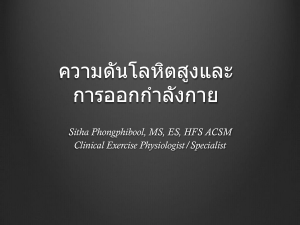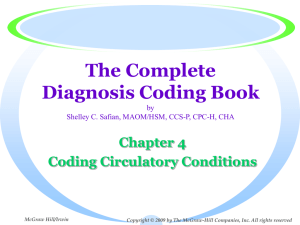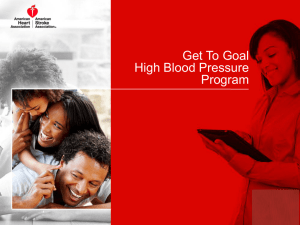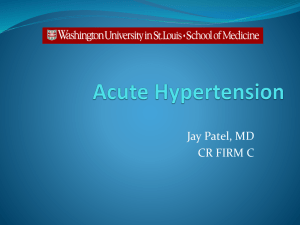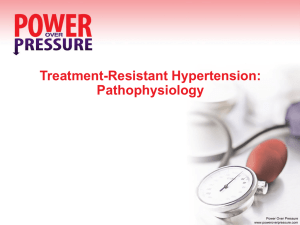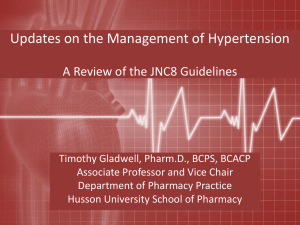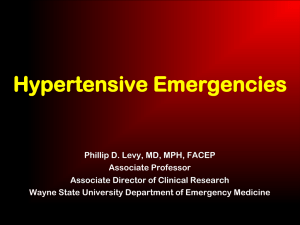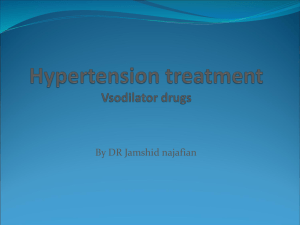Arterial Hypertension – general overview
advertisement
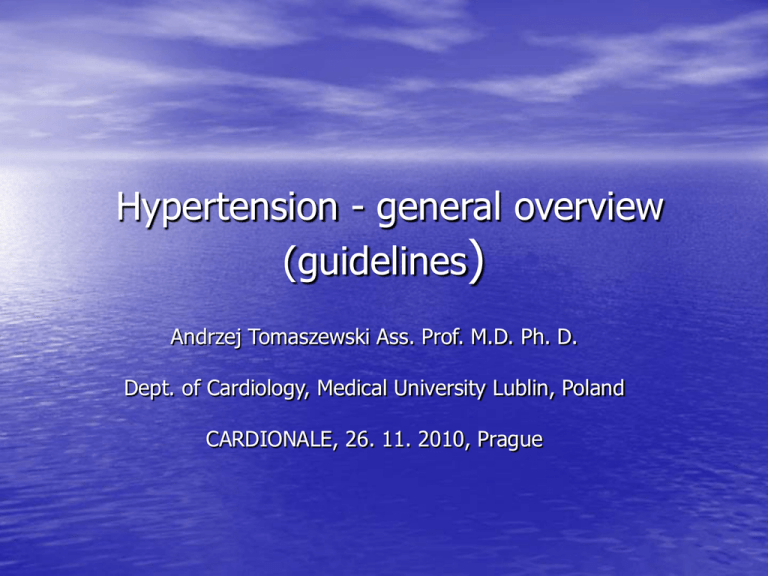
Hypertension - general overview (guidelines) Andrzej Tomaszewski Ass. Prof. M.D. Ph. D. Dept. of Cardiology, Medical University Lublin, Poland CARDIONALE, 26. 11. 2010, Prague History of BP measurement • In 1896 Riva-Rocci described an inflatable cuff that allowed measurement of brachial systolic pressure. • In 1904 Korotkov reported the auscultatory method that allowed measurement of systolic and diastolic pressure. Basis for the lecture: 2007 Guidelines for the management of arterial hypertension • The Task Force for the Management of Arterial Hypertension of the European Society of Hypertension (ESH) and of the European Society of Cardiology (ESC) • Authors/Task Force Members: Giuseppe Mancia, Co- Chairperson (Italy), Guy De Backer, Co-Chairperson (Belgium), Anna Dominiczak (UK), Renata Cifkova (Czech Republic), Robert Fagard (Belgium), Giuseppe Germano (Italy), Guido Grassi (Italy), Anthony M. Heagerty (UK), Sverre E. Kjeldsen (Norway), Stephane Laurent (France), Krzysztof Narkiewicz (Poland), Luis Ruilope (Spain), Andrzej Rynkiewicz (Poland), Roland E. Schmieder (Germany), Harry A.J. Struijker Boudier (Netherlands), Alberto Zanchetti (Italy) • European Heart Journal 2007;28:1462-1536 Basis for the lecture: Reappraisal of European guidelines on hypertension management: a European Society of Hypertension Task Force document 2009 • Giuseppe Mancia, Stephane Laurent, Enrico Agabiti-Rosei, Ettore Ambrosioni, Michel Burnier, Mark J. Caulfield, Renata Cifkova,Denis Cle´ment, Antonio Coca, Anna Dominiczak, Serap Erdine,Robert Fagard, Csaba Farsang, Guido Grassi, Hermann Haller,Antony Heagerty, Sverre E. Kjeldsen, Wolfgang Kiowski, Jean Michel Mallion,Athanasios Manolis, Krzysztof Narkiewicz, Peter Nilsson, Michael H. Olsen,Karl Heinz Rahn, Josep Redony Jose´ Rodicio, Luis Ruilopea,Roland E. Schmiedera, Harry A.J. Struijker-Boudiera, Pieter A. van Zwietena,Margus Viigimaaa and Alberto Zanchettia • Journal of Hypertension 2009, Vol 27,2121-58 Epidemiology of arterial hypertension • Arterial hypertension is one of the most prevalent cardiovascular diseases. • Arterial hypertension affects 20-50 % of adults in developed countries. • Frequency of arterial hypertension suddenly increases after 50 years of life (>50% of this population). • Worldwide, hypertension affects over 970 milion persons. Definition and classification of blood pressure levels (mmHg) • Category • • • • • • • • Systolic Diastolic Optimal <120 and <80 Normal 120–129 and/or 80–84 High normal 130–139 and/or 85–89 Grade 1 hypertension 140–159 and/or 90–99 Grade 2 hypertension 160–179 and/or 100–109 Grade 3 hypertension ≥180 and/or ≥110 Isolated syst. ≥140 and <90 hypertension Cumulative Incidence (%) of Major CV Events Impact of High-Normal BP on Risk of Major CV Events* in Men 1 6 1 4 1 2 1 0 8 High-normal BP (130-139/85-89 mm Hg) Normal BP (120-129/80-84 mm Hg) 6 Optimal BP (<120/80 mm Hg) 4 2 0 0 2 4 6 Time (y) 8 10 12 * Defined as death due to CV disease; recognized myocardial infarction (MI), stroke, or congestive heart failure (CHF). Adapted from Vasan RS. N Engl J Med. 2001;345:1291-1297. Arterial Hypertension as a risk factor • Hypertension is a highly prevalent risk factor for cardiovascular disease • Hypertension plays a major etiologic role in the development of cerebrovascular disease, ischemic heart disease, cardiac and renal failure Assessment of global cardiovascular risk in arterial hypertension • grades of hypertension • total cardiovascular risk (coexistence different risk factors, organ damage, concomitant diseases) Stratification of total CV risk • Four categories : • • • • - Low - Moderate - High - Very high refer to 10 year risk of fatal or non-fatal CV event Diagnostic evaluation in arterial hypertension • • • • • • • Establishing BP values Identyfying secondary causes of AH Searching for : -other risk factors -subclinical organ damage -concomitant diseases -accompanying CV and renal complications Diagnostic procedures in arterial hypertension • repeated BP measurements • family and clinical history • physical examination • laboratory and instrumental investigation Laboratory and instrumental investigationroutine tests • • • • • • • • • • Fasting plasma glucose Serum total cholesterol, LDL-cholesterol, HDL-cholesterol Fasting serum triglycerides Serum potassium Serum uric acid Serum creatinine Estimated creatinine clearance Haemoglobin and haematocrit Urinalysis Electrocardiogram Laboratory and instrumental investigation • Echocardiogram • Carotid ultrasound • Quantitative proteinuria • Fundoscopy • Glucose tolerance test (if fasting plasma glucose >5.6 mmol/L (100 mg/dL) • Home and 24 h ambulatory BP monitoring Left ventricular hypertrophy, parasternal long axis view Left ventricular hypertrophy, parasternal short axis view Left ventricular hypertrophy, four-chamber view Left ventricular hypertrophy, subcostal view Extended laboratory and instrumental investigation • Search for cerebral, cardiac, renal, vascular damage, for secondary hypertension: • measurement of renin, aldosteron,corticosteroids,catecholamines in plasma and/or urine • arteriographies, CT, MRI Secondary causes of AH : • Renal parenchymal disease (most common • • • • • • • cause) Renovascular hypertension (2nd most common cause) Pheochromocytoma Primary hyperaldosteronism Cushing’s syndrome Obstructive sleep apnea Coarctation of aorta Drug-induced hypertension Evidence on the benefit of antihypertensive treatment • Placebo controlled trials provided evidence that • • BP lowering reduces fatal and non-fatal CV events Trials comparing different antihypertensive drugs emphasise role of BP lowering of all CV events (stroke, myocardial infarction, heart failure) BP-independent effects (protection against subclinical organ damage, prevention of high risk condition such as diabetes, renal failure, atrial fibrillation) Benefits of Lowering BP Average reduction Stroke incidence 35–40% Myocardial infarction 20–25% Heart failure 50% Aim of antihypertensive therapy • The primary goal of treatment is to achieve • • maximum reduction in the long-term total risk of CV disease For this reason lowering BP therapy (at least < 140/90 mm Hg) and treatment of all reversible risk factors are indicated In diabetes and in high and very high risk patients BP target should be at least < 130/80 mmHg Treatment guidelines (ESH/ESC 2007) Average risk Low added risk Moderate added risk High added risk ESH – ESC Guidelines Committee. J Hypertens 2007; 25: 1105–1187 Very high added risk Lifestyle changes • • • • • • • smoking cessation weight reduction reduction of excessive alkohol intake physical exercise reduction of salt intake increase in fruit and vegetables intake decrease in saturated and total fat intake Choice of the antihypertensive drugs • Five major classes of these drugs are suitable for initiation and maintenance of treatment, alone or in combination : • thiazide diuretics • calcium antagonists (CA) • ACE-inhibitors (ACEI) • angiotensin receptor blockers (ARB) • beta-blockers (BB) Conditions favouring the use of some antihypertensive drugs versus other • Subclinical organ damage: LVH ACEI, CA, ARB Asymptomatic Atherosclerosis CA, ACEI Microalbuminuria ACEI, ARB Renal dysfunction ACEI, ARB Conditions favouring the use of some antihypertensive drugs versus other • Clinical event: Previous stroke Previous MI Heart failure any BP lowering agent BB, ACEI, ARB diuretics, BB, ACEI, ARB, anti-aldosterone agents Tachyarrhythmias BB Periph.art.disease CA LV dysfunction ACEI Conditions favouring the use of some antihypertensive drugs versus other • Condition : ISH (elderly) diuretics,CA Metabolic syndrome ACEI,ARB,CA Diabetes mellitus ACEI, ARB Pregnancy CA,methyldopa,BB Glaucoma BB Monotherapy versus combination therapy • Monotherapy allows to achieve BP target only in a limited number of patients • Use of more than one agent is necessary to achieve target BP • Initial therapy: monotherapy or combination of two drugs in low doses with subsequent increase in drug doses or number Monotherapy versus combination therapy • Monotherapy in mild BP elevation with low or • • • moderate total CV risk Two drugs at low doses should be preferred as the first step when BP is in grade 2 or 3 or total CV risk is high or very high with mild hypertension Fixed combination of two drugs simplify the treatment If BP control is not achieved by two drugs, combination of three or more drugs is required Possible combinations of different classes of antihypertensive agents Diuretics AT1-receptor β-blockers blockers α-blockers ACE, angiotensin-converting enzyme AT, angiotensin CCB, calcium-channel blocker CCBs ACE inhibitors The preferred combinations in general hypertensive population are represented as thick lines. The frames indicate classes of agents proven to be beneficial in controlled interventional trials ESH – ESC Guidelines Committee. J Hypertens 2007; 25: 1105–1187 Antihypertensive therapy in special groups • Elderly patients • Diabetic patients • Patients with renal dysfunction • Patients with cerebrovascular disease • Patients with coronary heart disease and heart failure • Patients with atrial fibrillation Hypertension in women • Response to antihypertensive drugs, beneficial effect of BP lowering is similar in men and women • Oral contraceptives • Hormone replacement therapy • Hypertension in pregnancy Resistant hypertension • Poor adherence to therapeutic plan • Failure to modify lifestyle including: weight gain, • • • • • heavy alcohol intake Intake of drugs that raise blood pressure Obstructive sleep apnoea Unsuspected secondary cause Irreversible or scarcely reversible organ damage Volume overload due to:inadequate diuretic therapy, progressive renal insufficiency, high sodium intake, hyperaldosteronism Unsuspected secondary cause Unsuspected secondary cause Unsuspected secondary cause Coarctation of aorta Unsuspected secondary cause Coarctation of aorta Malignant hypertension • Clear overlap between resistant and malignant hypertension • Severe BP elevation (DBP usually >140 mmHG) with vascular damage (retinal haemorrhage, papilloedema, hypertensive encephalopathy,deterioration in renal function, DIC) Hypertensive emergiences • • • • • • • • • • Hypertensive encephalopathy Hypertensive left ventricular failure Hypertension with myocardial infarction Hypertension with unstable angina Hypertension and dissection of the aorta Severe hypertension associated with subarachnoid haemorrhage or cerebrovascular accident Crisis associated with phaeochromocytoma Use of recreational drugs such as amphetamines, LSD, cocaine or ecstasy Hypertension perioperatively Severe pre-eclampsia or eclampsia Echocardiography • Examples of two hypertensive emergencies: - aortic dissection - fatal myocardial infarction Aortic dissection Aortic dissection Chronic aortic dissection Chronic aortic dissection Fatal myocardial infarction Fatal myocardial infarction Fatal myocardial infarction Fatal myocardial infarction Fatal myocardial infarction,cardiac tamponade Hypertension – treatment of associated risk factors • Lipid lowering agents: - all hypertensive pts with CV disease or diabetes should be considered for statin therapy aiming total cholesterol < 175 mg/dl and LDL < 100mg/dl - pts with high CV risk should be considered for statin therapy, even if total and LDL cholesterol are not elevated Hypertension – treatment of associated risk factors • Antiplatelet therapy (low dose aspirin): -for pts with previous CV events -for pts without history of CV disease if older than 50 y., with moderate increase in serum creatinine or with high CV risk • Glycemic control : - lowering fasting plasma glucose to 108 mg/dl, glycated hemoglobin of <6,5% Reappraisal of European guidelines on hypertension management: a ESH Task Force document, 2009 What is new today after reappraisal 2009 ? 1/Some of new studies have reinforced the evidence on which the recommendations of the 2007 ESH/ESC guidelines were based 2/Other studies have widened the information available in 2007 3/Modifying some of the previous concepts 4/New evidence-based recommendations could be appropriate. Reappraisal of European guidelines on hypertension management: a ESH Task Force document, 2009 New evicence-based recommendations: - blood pressure goals of treatment - indications for starting antihypertensive pharmacotherapy Reappraisal of European guidelines on hypertension management: a ESH Task Force document, 2009 • Blood pressure goals of treatment: there is sufficient evidence to recommend that SBP be lowered below 140mmHg (and DBP below 90mmHg) in all hypertensive patients, both those at low moderate risk and those at high risk. The recommendation of previous guidelines to aim at a lower goal SBP (<130mmHg) in diabetic patients and in patients at very high cardiovascular risk (previous cardiovascular events) may be wise, but it is not consistently supported by trial evidence. Reappraisal of European guidelines on hypertension management: a ESH Task Force document, 2009 • Blood pressure goals of treatment: on the basis of current data, it may be prudent to recommend lowering SBP/DBP to values within the range 130–139/80–85mmHg, and possibly close to lower values in this range, in all hypertensive patients. Reappraisal of European guidelines on hypertension management: a ESH Task Force document, 2009 • Indications for starting antihypertensive pharmacotherapy In the vast majority of hypertensive patients, effective BP control can only be achieved by combination of at least two antihypertensive drugs. Reappraisal of European guidelines on hypertension management: a ESH Task Force document, 2009 • Recommended combinations for priority use: • Diuretic + ACEI • Diuretic + ARB • Diuretic + CA • ACEI + CA • ARB +CA Reappraisal of European guidelines on hypertension management: a ESH Task Force document, 2009 • Not recommended combinations: • Beta-blocker + diuretic combination favors the • development of diabetes ACE inhibitor + angiotensin receptor antagonist combination presents dubious potentiation of benefits with a serious side efects Reappraisal of European guidelines on hypertension management: a ESH Task Force document, 2009 • In no less than 15–20% of patients, BP control cannot be achieved by a two-drug combination. • The most rational combination of three drugs appears to be a blocker of the renin–angiotensin system, a calcium antagonist, and a diuretic at effective doses. • β-blocker or an α-blocker, may be included in a multiple approach, depending on the clinical circumstances. Thank you for your attention
